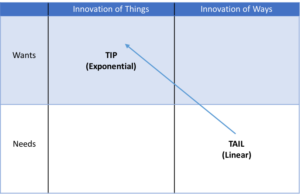I recently watched an excellent TED talk by Dan Pollata called “The Dreams We Haven’t Dared to Dream”. In his talk, Dan eloquently notes that while human ingenuity has exponentially increased the transistors on a chip for the past 40 years, we have not applied the same exponential thinking to our dreams nor human compassion. As he says, “we continue to make a perverse trade-off between our future dreams and our present state of evolution”.
Some describe this ethical stasis as “the tyranny of the OR”
In a similar vein, Stephen Hawking wrote in his book, On Equality, “If machines produce everything we need, the outcome will depend on how things are distributed. Everyone can enjoy a life of luxurious leisure if the machine-produced wealth is shared, or most people can end up miserably poor if the machine-owners successfully lobby against wealth redistribution. So far, the trend seems to be toward the second option, with technology driving ever-increasing inequality.”
Unilever’s CEO, Paul Polman, put it more succinctly as he talked about the exponential growth of new technologies, “Power is dispersed, but wealth is concentrated”.
From my perspective and research for the book, Tip of the Spear, I have called it the challenge of the Innovation of Things versus the Innovation of Ways.
I will be discussing this in more detail in the book but I wanted to put this idea out there for feedback.
Innovation of Things is – as it name suggests – the creation of new tools, toys and devices that serve to make human live better, easier or interesting. It is the cars that move us, the computers that connect us and so much more. It is the “What”.
Innovation of Ways is the use of these tools to change the way we do something – from the way we build our cities, to how we share rides or rooms to how we run our finances or build our organizations. It is the “How”.
In the history of the world of innovation, How most often follows What.
But there is a growing conflict. The tension between the power of technology to create new and magical things (The What) and the ability of the human species to understand and absorb it all (the How) is central to my thesis of the book. It is growing more more acute every day.
Much of the Innovation I speak about in the Tip of the Spear – that is, the white hot edge of technology disruption – centers on the Innovation of Things: Robotics, AI, VR/AR and the long list of exponential technologies.
In my opinion, we are suffering because the Innovation of Ways is lagging – in many cases significantly.
But let’s add a second dimension to this to see if we can understand this a bit better. In my research it has helped me to think about how innovation is also broken down into Innovation for Wants and Innovation for Needs.
There is very, very different dynamic of capital flow, timeline horizons and even the type of individuals who are involved in these different areas.
It kind of looks like this – using my “Tip of the Spear” analogy.
Intuitively this makes sense. In a market and capital driven system, the return of capital in the top left quadrant is likely (I have no data – yet – on this) shortest, most obvious and highest. Anecdotally, it has often been said that the earliest use of the newest technologies is often the adult porn industry. New “toys” being applied to the most obvious and basest of “wants”. Just check out want’s happening in Virtual Reality and think back to the introduction of VHS, the internet and many others through out history. Gaming is a close second.
But – of course – this is far too simplistic in this extraordinary time of innovation and technological advances. We are seeing new devices that are the result of combinations of exponential technologies in all areas of our lives. Many innovations start in the upper quadrant, then move down into the bottom left.
But what about the Innovation of Ways? Coming back to Dan Pollata, I feel somehow – and my research is strongly hinting at this – that we are lacking the same heat and light in the areas of changing the way Government works, the Education systems and heath care for example. These are clearly the “ways” of life – how we govern, organize, teach and heal.
My optimist side says that the new technology winners in the Innovation of Things will begin to turn their attention to the Innovation of Ways. That is why I am so interested in what Mark Zuckerberg is doing with his Internet.org initiative to connect the planet to the Internet. The cynic would say that it is to add more users to Facebook. But on very close read and observation – short of speaking directly with Mark – that is clearly not the case.
The pessimists will say that we are stalling in our global thinking that will transfer the best the Innovation of Things to the Ways of the world due to walls being built – literally and figuratively – across the world and the deep and concerning concentration of wealth and power with the new titans of technology.
The debate is the essence of the Tip of the Spear.
Would love your thoughts.
Jim

